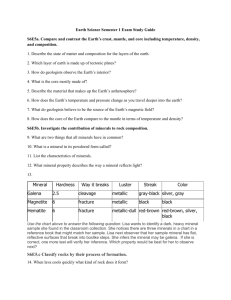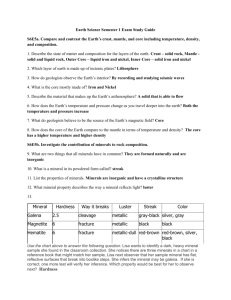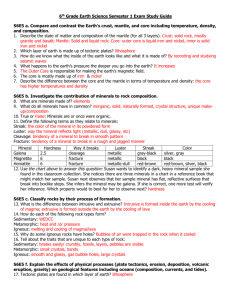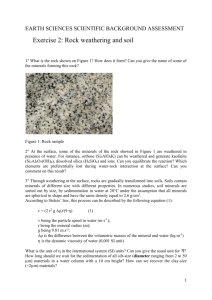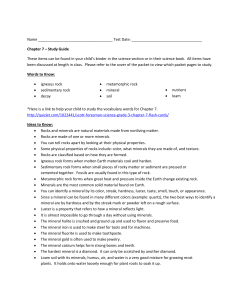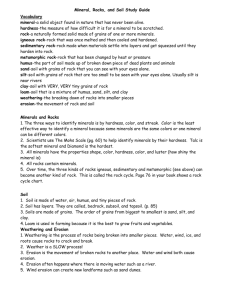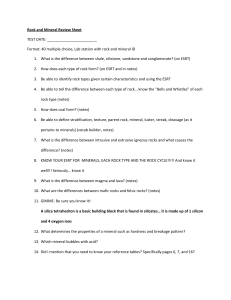Earth Science Semester 1 Exam Study Guide S6E5a. Compare and
advertisement
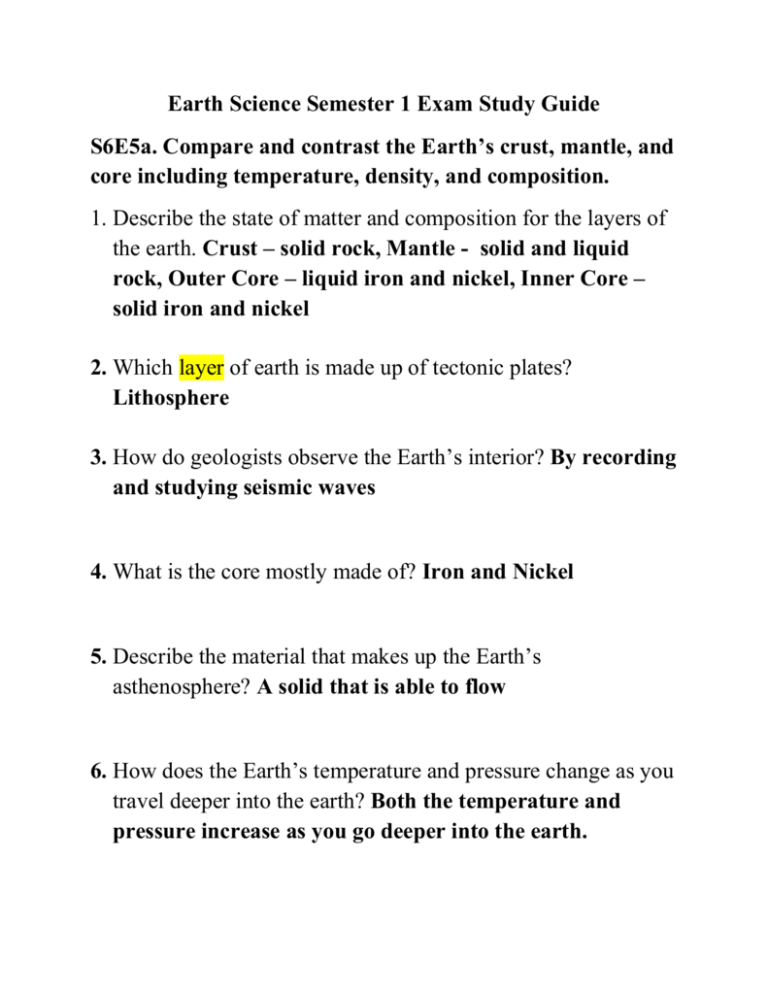
Earth Science Semester 1 Exam Study Guide S6E5a. Compare and contrast the Earth’s crust, mantle, and core including temperature, density, and composition. 1. Describe the state of matter and composition for the layers of the earth. Crust – solid rock, Mantle - solid and liquid rock, Outer Core – liquid iron and nickel, Inner Core – solid iron and nickel 2. Which layer of earth is made up of tectonic plates? Lithosphere 3. How do geologists observe the Earth’s interior? By recording and studying seismic waves 4. What is the core mostly made of? Iron and Nickel 5. Describe the material that makes up the Earth’s asthenosphere? A solid that is able to flow 6. How does the Earth’s temperature and pressure change as you travel deeper into the earth? Both the temperature and pressure increase as you go deeper into the earth. 7. What do geologists believe to be the source of the Earth’s magnetic field? Core 8. How does the core of the Earth compare to the mantle in terms of temperature and density? The core has a higher temperature and higher density S6E5b. Investigate the contribution of minerals to rock composition. 9. What are two things that all minerals have in common? They are formed naturally and are inorganic 10. What is a mineral in its powdered form called? Streak 11a. What are the properties of minerals? Hardness, the way it breaks (cleavage or fracture), luster, streak, color 11b. List the characteristics of minerals. Minerals are naturally formed, inorganic, an element or a compound (more than one element), and have a crystalline structure, unique chemical formula 12. What mineral property describes the way a mineral reflects light? Luster 13. Mineral Hardness Way it breaks Luster Streak Color Galena 2.5 Cleavage metallic gray-black silver, gray Magnetite 6 Fracture metallic black Hematite 6 Fracture metallic-dull red-brown red-brown, silver, black black Use the chart above to answer the following question: Lisa wants to identify a dark, heavy mineral sample she found in the classroom collection. She notices there are three minerals in a chart in a reference book that might match her sample, Lisa next observed that her sample mineral has flat, reflective surfaces that break into boxlike steps. She infers the mineral may be galena. If she is correct, one more test will verify her inference. Which property would be best for her to observe next? Hardness 6E5.c Classify rocks by their process of formation. 14. When lava cools quickly what kind of rock does it form? Extrusive igneous 15. What is the order of events in the formation of sedimentary rocks? Weathering, erosion, deposition, compaction, cementation (W.E.D.C.C.) 16. What characteristic is common to metamorphic rocks? Foliated = Ribbon-like layers 17. What characteristic is found in sedimentary rock? Fossils 18. Why do some igneous rocks have holes? Bubbles of air (gas) were trapped in the rock when it cooled quickly 19. What type of rock is tan in color, fine-grained, and contains fossils? Sedimentary rock S6E5.f Explain the effects of physical processes (plate tectonics, erosion, deposition, volcanic eruption, gravity) on geological features including oceans (composition, currents, and tides). 20. Which layer(s) of the Earth is a combination of the crust and the upper mantle? Lithosphere 21. Why was Alfred Wegener’s idea of continental drift rejected? Wegener could not identify a force that could move the continents 22. What is the process by which the ocean floor sinks beneath a deep-ocean trench and back into the mantle? Subduction 23. Where are the results of the plate movement seen ? Plate Boundaries 24. What is the main reason that the continents look very different than they did 100 million years ago? The continents have drifted apart from one another on plates 25. What causes the movement of the Earth’s tectonic plates? Convection currents 26. What is not used as evidence to support the theory of continental drift? The existence of convection currents 27. What are U-shaped valleys formed by? Glaciers 28. What causes sediment and rock to move to lower elevations through time? Gravity S6E5.h Describe soil as consisting of weathered rocks and decomposed organic material. 29. What does organic matter break down into? Nutrients 30. What is humus? The decomposed organic matter or material in soil 31. How does soil receive the nutrients that it gets to be healthy soil? When organic matter decays and turns into humus 32. Al wants to determine in which horizon an unknown type of soil is found. He finds out through testing that it is dark and contains a lot of decomposed organic matter. He determines that this kind of soil is found in _____topsoil____________ 33. How are minerals carried from the A horizon to the B horizon? Leaching S6E6. Students will describe various sources of energy and their uses and conservation. 34. When people practice conservation, they ___use their resources wisely_____. 35. What can be burned to produce biomass? wood, garbage, and organic material 36. List the energy resources that are used as alternatives to or instead of fossil fuels. Wind, solar, hydroelectric, nuclear, biomass, geothermal energies 37. Places where magma is close to the Earth’s surface may be suitable for generating what? Geothermal energy 38. I am used mainly in the western US. My energy comes from the heat within the Earth. I can be used for home heating. Water that is piped down to me is turned into steam to turn turbines and generate energy. What am I? Geothermal energy S6E6.b Identify renewable and nonrenewable resources. 39. A resource that after being used can be replaced in a short amount of time is said to be what? Renewable resources
